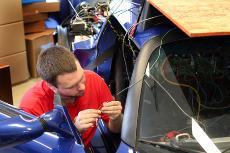Four years ago when the Defense Advanced Research Projects Agency announced a competition for autonomous ground vehicles they fast tracked innovation in the most economic way possible.
After the first competition, DARPA spent $13 million, but received $64 million in technology advancements, according to Grayson Randall, the leader of the Insight Racing team.
Once Randall read about the challenge of sending an autonomous vehicle across desert terrain guided by GPS waypoints he said, “I can do that,” and he began a team that participated in the second challenge, and is now building a vehicle for the third challenge.
The “Lone Wolf” is a Lotus Elise that Insight Racing is preparing to drive autonomously through city streets for the next competition, which takes place in November.
Last night Randall spoke at the engineering school’s innovators forum with Dick Dell, founder of the Advanced Research Vehicle Center, and Simon Cobb, of Lotus Engineering, to discuss advancements in automotive technology.
“The purpose [of the forum] is to advertise the technologies that are coming out of NCSU engineering,” Tara Britt, director of administration and external relations, said. “We want to let people know about the technologies that begin startup companies and other venture opportunities.”
The forums take place on the third Monday of every month, but last night’s broke the usual mode of entrepreneurship and technology in business through its topic of automotive development.
“We are trying to gear up excitement [about the DARPA challenge] because we are the only university in North Carolina participating and students are developing technology used in the car,” Britt said.
Randall spoke about the developments used in the DARPA vehicle, Dell spoke on alternative fuel research in the AVRC, and Cobb about the history of automotive innovation and what he sees for the future.
The DARPA Elise is a dark blue tangle of body panels and wires equipped with technology of the future. The front has laser range finders to sweep the area to receive a map of the objects surrounding it, because in November competition the vehicle must maneuver around other cars while obeying city traffic laws.
On the top of the car GPS locates and places the vehicle in space. At the last competition in 2005 the “Desert Rat,” a 1987 suburban, relied much more heavily on GPS for its positioning in the desert because it only used waypoints for direction. In November, the “Lone Wolf” will use its laser technology bouncing off the side of the road and other objects combined with its GPS to understand direction.
The car must collect all of this information in real-time data, condense it into usable information, and then make real-time decisions at up to 45 mph.
“It is a very difficult software problem,” Randall said.
The car is packed with hardware to hasten the process as much as possible, with nine Mac Minis lining the trunk full of wires.
The DARPA challenge presents problems with innovation as a must, and Randall attacks those problems by defining the goal, writing ideas down, and creating a series of checkpoints to keep himself on track.
He identified the problem many of the teams at the last challenge as having focused on only the big problem, and not what was most important – the technologies.
“You need to focus on the thing with the most value,” Randall said.
Issues such as bad weather – rain or wind – he finds as less important than having a vehicle that can run in perfect weather, because concentrating on those types of issues is what distracts the engineers from completing the task.
The way to tackle the technologies is a different issue though, an issue Randall as team leader must deal with through innovative ideas.
The optical software and interpretations for the vehicle are what Randall identified as the most difficult obstacle because all the information becomes a pixilated map the computer must understand. But one time he received an easy answer on how to fix the problem – place a stick on the front to feel.
“But when you are going 45 mph you need a really long stick,” Randall said.
Ideas are what drive their innovation though, even if the ideas seem outlandish at first. Cobb said that the technologies Insight Racing is developing are the technologies that he sees as having a “very big presence” in the future for safety reasons.
He cited examples such as the evolution of air bags and anti-lock brakes as technologies that have advanced automobiles — but also began as crude technologies. And between 1960 and 2002 advancements such as these saved 328,551 lives, according to the national Highway Traffic Safety Administration.
Harnessing these innovations also takes flexibility once the idea is executed, Randall emphasized.
“When I go to solve a problem time is a critical point where you have to decide: is it more important to finish this problem? Or back up and say, ‘Is there a better way to do this?'” he said.
The innovators forum gives students and faculty an opportunity to analyze the work presented and ask those questions.








